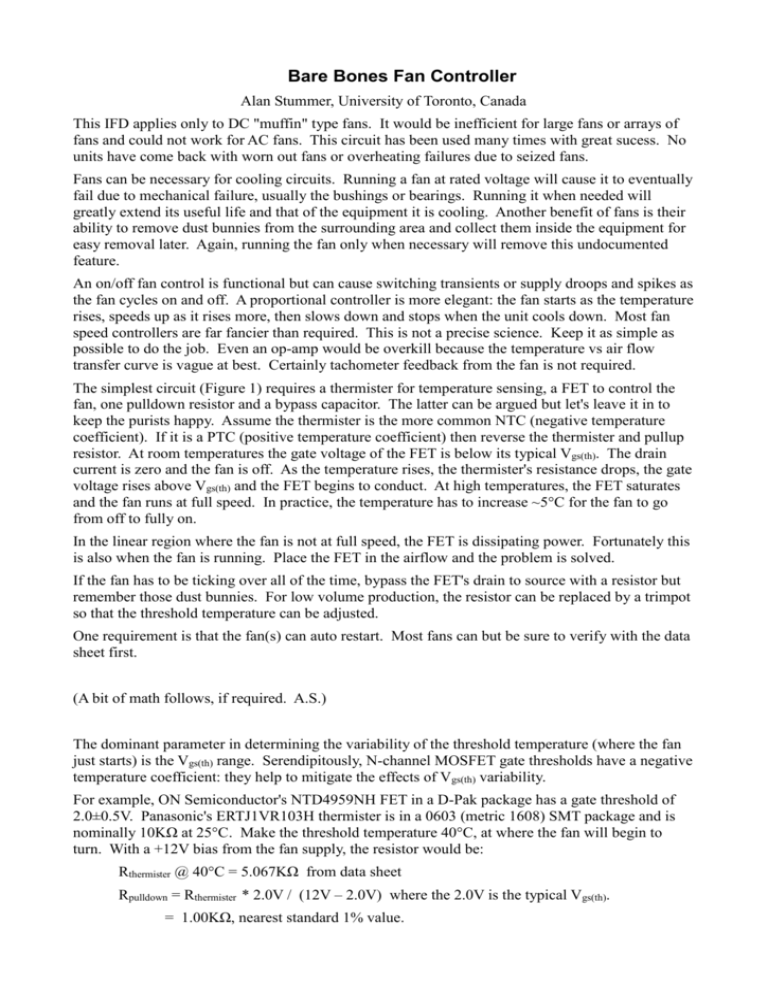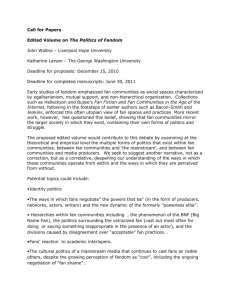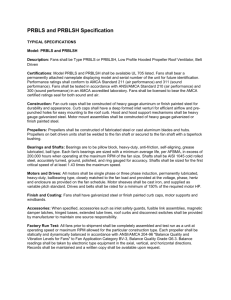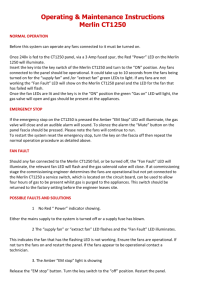Bare Bones Fan Controller
advertisement

Bare Bones Fan Controller Alan Stummer, University of Toronto, Canada This IFD applies only to DC "muffin" type fans. It would be inefficient for large fans or arrays of fans and could not work for AC fans. This circuit has been used many times with great sucess. No units have come back with worn out fans or overheating failures due to seized fans. Fans can be necessary for cooling circuits. Running a fan at rated voltage will cause it to eventually fail due to mechanical failure, usually the bushings or bearings. Running it when needed will greatly extend its useful life and that of the equipment it is cooling. Another benefit of fans is their ability to remove dust bunnies from the surrounding area and collect them inside the equipment for easy removal later. Again, running the fan only when necessary will remove this undocumented feature. An on/off fan control is functional but can cause switching transients or supply droops and spikes as the fan cycles on and off. A proportional controller is more elegant: the fan starts as the temperature rises, speeds up as it rises more, then slows down and stops when the unit cools down. Most fan speed controllers are far fancier than required. This is not a precise science. Keep it as simple as possible to do the job. Even an op-amp would be overkill because the temperature vs air flow transfer curve is vague at best. Certainly tachometer feedback from the fan is not required. The simplest circuit (Figure 1) requires a thermister for temperature sensing, a FET to control the fan, one pulldown resistor and a bypass capacitor. The latter can be argued but let's leave it in to keep the purists happy. Assume the thermister is the more common NTC (negative temperature coefficient). If it is a PTC (positive temperature coefficient) then reverse the thermister and pullup resistor. At room temperatures the gate voltage of the FET is below its typical Vgs(th). The drain current is zero and the fan is off. As the temperature rises, the thermister's resistance drops, the gate voltage rises above Vgs(th) and the FET begins to conduct. At high temperatures, the FET saturates and the fan runs at full speed. In practice, the temperature has to increase ~5°C for the fan to go from off to fully on. In the linear region where the fan is not at full speed, the FET is dissipating power. Fortunately this is also when the fan is running. Place the FET in the airflow and the problem is solved. If the fan has to be ticking over all of the time, bypass the FET's drain to source with a resistor but remember those dust bunnies. For low volume production, the resistor can be replaced by a trimpot so that the threshold temperature can be adjusted. One requirement is that the fan(s) can auto restart. Most fans can but be sure to verify with the data sheet first. (A bit of math follows, if required. A.S.) The dominant parameter in determining the variability of the threshold temperature (where the fan just starts) is the Vgs(th) range. Serendipitously, N-channel MOSFET gate thresholds have a negative temperature coefficient: they help to mitigate the effects of Vgs(th) variability. For example, ON Semiconductor's NTD4959NH FET in a D-Pak package has a gate threshold of 2.0±0.5V. Panasonic's ERTJ1VR103H thermister is in a 0603 (metric 1608) SMT package and is nominally 10KΩ at 25°C. Make the threshold temperature 40°C, at where the fan will begin to turn. With a +12V bias from the fan supply, the resistor would be: Rthermister @ 40°C = 5.067KΩ from data sheet Rpulldown = Rthermister * 2.0V / (12V – 2.0V) where the 2.0V is the typical Vgs(th). = 1.00KΩ, nearest standard 1% value. Working backwards with the extreme upper and lower Vgs(th) gives the worst case temperature thresholds. Vgs(th) min = 1.5V from data sheet. Rthermister = 1.00KΩ * (12V – 1.5V) / 1.5 where 1.00KΩ is Rpulldown = 7.00KΩ = 33°C Similarly, the highest threshold temperature would be 3.80KΩ and 46°C. However, we all know that the majority of parts will fall into the middle of the range so a threshold temperature of 40±3°C would be expected. Figure 1. Bare Bones Fan Controller example schematic






